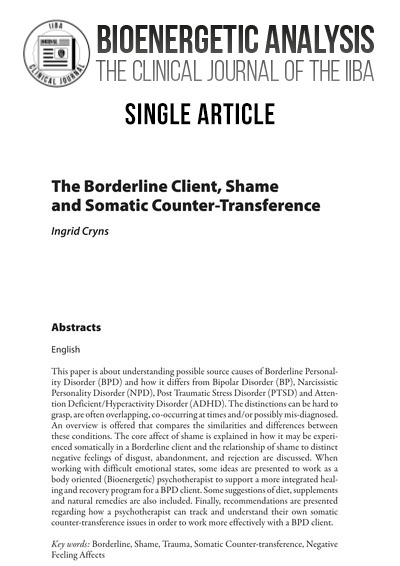The Borderline Client, Shame and Somatic Counter-Transference
DOI:
https://doi.org/10.30820/0743-4804-2017-27-111Keywords:
Borderline, Shame, Trauma, Somatic Counter-transference, Negative Feeling AffectsAbstract
This paper is about understanding possible source causes of Borderline Personality Disorder (BPD) and how it differs from Bipolar Disorder (BP), Narcissistic Personality Disorder (NPD), Post Traumatic Stress Disorder (PTSD) and Attention Deficient/Hyperactivity Disorder (ADHD). The distinctions can be hard to grasp, are often overlapping, co-occurring at times and/or possibly mis-diagnosed. An overview is offered that compares the similarities and differences between these conditions. The core affect of shame is explained in how it may be experienced somatically in a Borderline client and the relationship of shame to distinct negative feelings of disgust, abandonment, and rejection are discussed. When working with difficult emotional states, some ideas are presented to work as a body oriented (Bioenergetic) psychotherapist to support a more integrated healing and recovery program for a BPD client. Some suggestions of diet, supplements and natural remedies are also included. Finally, recommendations are presented regarding how a psychotherapist can track and understand their own somatic counter-transference issues in order to work more effectively with a BPD client.
How to Cite
Issue
Section
License

This work is licensed under a Creative Commons Attribution-NonCommercial-NoDerivatives 4.0 International License.
This work is licensed under the Creative Commons Attribution-NonCommercial-NoDerivatives 4.0 International License (CC BY-NC-ND 4.0). This license allows private use and unmodified distribution, but prohibits editing and commercial use (further information can be found at: https://creativecommons.org/licenses/by-nc-nd/4.0/). The terms of the Creative Commons licence only apply to the original material. The reuse of material from other sources (marked with a reference) such as charts, illustrations, photos and text extracts may require further permission for use from the respective copyrights holder.


